Downward spiral: Nicaragua's worsening crisis
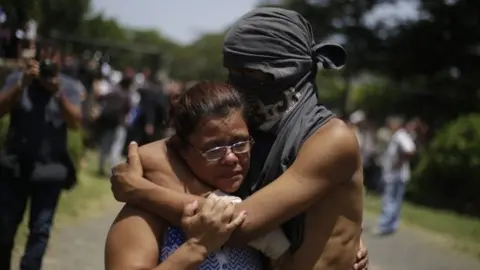 EPA
EPAHundreds of people have been killed in Nicaragua since 18 April in what has become a popular uprising against the Central American country's president, Daniel Ortega, and his government. BBC News takes a closer look at how the crisis unfolded.
How did it all start?
The crisis started rather unexpectedly when pro-government groups violently crushed a small demonstration against reforms to Nicaragua's pension system announced on 18 April.
These pro-government groups, popularly known as "grupos de choque" (shock forces) had in the past been used to repress anti-government protests and had discouraged many Nicaraguans disgruntled with President Ortega from taking to the streets.
But this time footage of the repression, which was widely shared on social media, caused outrage and triggered more protests which in turn were met with further repression.
Three people, among them a police officer, were killed on 19 April amid attempts by the security forces to suppress the demonstrations.
What's happened since?
Hundreds of people have been killed and thousands injured as the protests have grown and attempts to suppress them intensified.
Anger at the government has kept on increasing with rising fatalities. The country is littered with roadblocks and barricades, which the security forces have been trying to clear.
There are almost daily reports of clashes turning lethal. Protesters blame the security forces and paramilitary groups loyal to the government for the violence while the authorities have labelled the protesters as "terrorists".
How many have been killed?
The government has not released any official figures in recent weeks, saying that each and every death has to be investigated thoroughly before accurate numbers can be given.
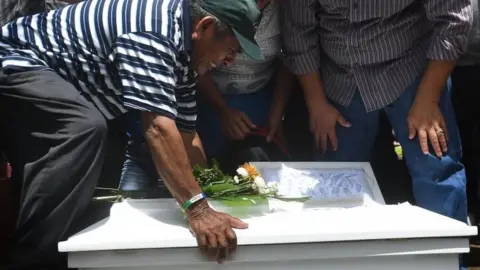 AFP
AFPThe Inter-American Commission of Human Rights (IACHR) said 264 people had been killed between the start of the protests and 11 July.
Human rights groups inside Nicaragua say the figure is now up to more than 300.
Why are the protest so deadly?
Protesters allege that the security forces employ excessive force, using live bullets and sharpshooters against demonstrators.
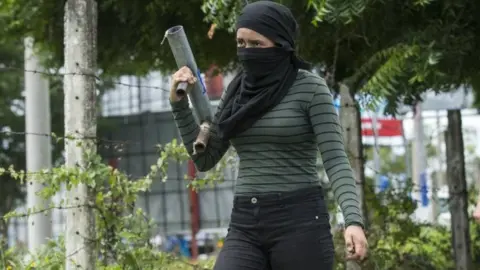 EPA
EPAIt is an allegation which has been echoed by a number of human rights groups. Amnesty International said last week that "state repression has reached deplorable levels" in Nicaragua.
The United Nations Office for Human Rights has also warned of "the dangerous spiral of violence and impunity" it says Nicaragua is sliding into.
Allow Twitter content?
The government denies the violence is one-sided and points to the use of home-made mortars by the protesters as evidence that the security forces come under attack.
A number of police officers have been among those killed. The government has also pointed to instances in which government supporters have been attacked to back up their claim that the protesters are "terrorists".
But most human rights groups agree that the paramilitary groups, or "grupos de choque", have played a particularly deadly role in the conflict.
What do the protesters want?
With hundreds of thousands taking to the streets, the demands have become much broader than the original protests against changes to the pension system, which were scrapped shortly after the protests began.
 EPA
EPAUniversity students are at the forefront of the protests but the movement prides itself on having the support of Nicaraguans from all walks of life and of all political affiliations.
They have also been joined by many in the business sector, who in the past broadly supported President Ortega.
They are united in their demand for justice for those killed during the demonstrations. They are also demanding deep democratic reforms, with many believing neither can be achieved if President Ortega - who is on his third consecutive term in office - remains in power.
Many are therefore calling for Mr Ortega to step down or at least for early elections to take place, both of which the leader has ruled out arguing that it would go against the constitution.
What does the government say?
The government has blamed the situation on criminal groups and "opposition political groups with specific political agendas".
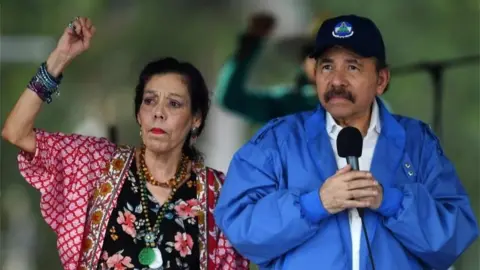 AFP
AFPIt says the protesters are "inflicting suffering on Nicaraguan families" by severely disrupting everyday life.
In a statement published on 9 July, the government accuses the protesters of killing, torturing and kidnapping hundreds of citizens and of looting and setting alight homes and businesses.
The government says it has "the duty to defend the security and peace" of all Nicaraguans, including "the right of people, vehicles and goods to move freely throughout the territory".
It has launched an operation dubbed "clean-up" which it says is aimed at restoring order, but protesters accuse the security forces deployed of dragging opposition activists from their homes and illegally detaining them.
What might happen next?
There has been widespread international condemnation of the Nicaraguan government and calls for the security forces to be reined in but so far to little effect.
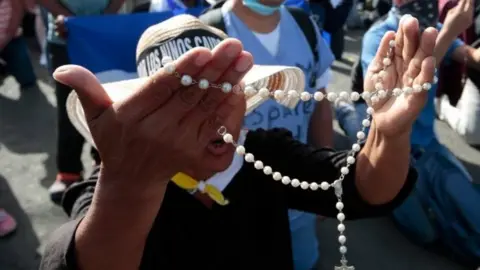 Reuters
ReutersBusinesses have been suffering, especially those in the tourism sector, and with protesters threatening to call further strikes an estimated 85,000 jobs could be lost this year.
A "national dialogue" in which protesters sat down with members of the government with the mediation of the Catholic Church has so far achieved very little and stalled repeatedly.
With talks stalled, President Ortega ruling out early elections and protesters saying that there is no going back, the crisis seems likely to further escalate.

